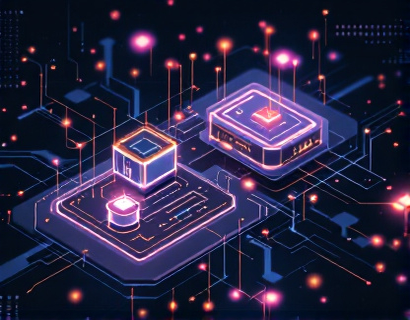Mastering Digital Currency Creation: A Guide to Cutting-Edge Software for Businesses and Blockchain Innovators
In the rapidly evolving landscape of blockchain technology, the ability to create and manage digital currencies has become an essential skill for businesses and innovators. This guide delves into the intricacies of using advanced software to master digital currency creation, focusing on customization, security, and scalability. By leveraging cutting-edge tools, both novices and experts can navigate the complexities of blockchain with confidence and ease.
Understanding Digital Currency Creation
Digital currencies, also known as cryptocurrencies, operate on blockchain technology, a decentralized ledger that records transactions across multiple computers. Creating a digital currency involves several steps, from designing the token's specifications to deploying it on a blockchain network. The process can be daunting, but with the right software, it becomes more manageable and accessible.
Key Features of Advanced Digital Currency Software
Modern software for digital currency creation offers a suite of features designed to simplify and enhance the development process. These features include:
- Customizable Token Parameters: Define the unique characteristics of your digital currency, such as total supply, distribution model, and reward mechanisms.
- Robust Security Protocols: Ensure the integrity and safety of your currency through advanced cryptographic techniques and secure coding practices.
- Seamless Integration: Easily integrate your digital currency with existing blockchain platforms and ecosystems, facilitating broader adoption and use.
- Scalability Solutions: Design your currency to handle increasing transaction volumes and user growth without compromising performance.
- User-Friendly Interfaces: Intuitive dashboards and tools that make it easy for users of all skill levels to manage and monitor their digital currencies.
Customization Options
One of the most significant advantages of using advanced software for digital currency creation is the level of customization available. Here are some key aspects that can be tailored to meet specific business needs:
Token Structure: Define the type of token, such as utility tokens, security tokens, or stablecoins, each with different use cases and regulatory considerations.
Supply and Distribution: Set the total number of tokens, initial distribution methods, and mechanisms for future issuance or burning tokens to control inflation and scarcity.
Incentive Mechanisms: Implement reward systems for miners, validators, or users to encourage participation and maintain network security.
Smart Contract Functionality: Integrate smart contracts to automate complex processes, enforce rules, and create decentralized applications (dApps) around your digital currency.
Security Considerations
Security is paramount in the world of digital currencies. Advanced software addresses this by incorporating several critical features:
Cryptographic Algorithms: Utilize state-of-the-art cryptographic techniques to secure transactions and protect user funds.
Code Audits and Testing: Regularly conduct thorough code reviews and penetration testing to identify and fix vulnerabilities before deployment.
Multi-Signature Wallets: Implement multi-signature requirements for critical operations, adding an extra layer of security.
Compliance Tools: Ensure adherence to regulatory requirements by integrating compliance checks and reporting mechanisms.
Scalability and Performance
As your digital currency grows, it must handle increasing loads without degradation in performance. Advanced software addresses scalability through:
Sharding: Divide the blockchain into smaller, manageable parts to process transactions in parallel, enhancing throughput.
Layer 2 Solutions: Implement off-chain transactions to reduce network congestion and lower transaction fees.
Dynamic Adjustments: Allow for automatic adjustments in block sizes, difficulty levels, and other parameters to maintain optimal performance.
High Availability: Ensure the network remains accessible and operational even under heavy loads, using redundant systems and failover mechanisms.
User Experience and Accessibility
To foster widespread adoption, digital currency software should prioritize user experience and accessibility. Key considerations include:
Intuitive Dashboards: Provide clear, easy-to-understand interfaces for managing tokens, viewing transactions, and monitoring network health.
Educational Resources: Offer tutorials, guides, and documentation to help users understand and utilize the digital currency effectively.
Multi-Language Support: Make the software accessible to a global audience by supporting multiple languages.
Mobile Compatibility: Ensure that the user interface is responsive and functional on various devices, including smartphones and tablets.
Case Studies and Success Stories
Several businesses and projects have successfully leveraged advanced digital currency software to achieve their goals. For instance, a fintech company used the platform to launch a stablecoin for international payments, achieving high transaction speeds and low fees. Another project utilized the software to create a utility token for a decentralized gaming platform, fostering a vibrant community of developers and players.
These success stories highlight the versatility and effectiveness of advanced digital currency software in various applications, from finance to gaming and beyond.
Future Trends and Innovations
The landscape of digital currency creation is continually evolving, with new trends and innovations on the horizon. Some of the emerging areas include:
Interoperability: Developing standards and protocols that allow different blockchain networks to communicate and transfer assets seamlessly.
Decentralized Finance (DeFi): Expanding the use of digital currencies in financial services, including lending, borrowing, and decentralized exchanges.
Non-Fungible Tokens (NFTs): Exploring the potential of unique digital assets represented on the blockchain, with applications in art, collectibles, and more.
Sustainability: Focusing on environmentally friendly consensus mechanisms and energy-efficient blockchain solutions.
Conclusion
Mastering digital currency creation is no longer the domain of tech experts alone. With advanced software designed for customization, security, and scalability, businesses and blockchain innovators can confidently enter and thrive in the digital currency space. By leveraging these tools, users can create robust, secure, and scalable digital currencies that meet their specific needs and drive innovation.










































